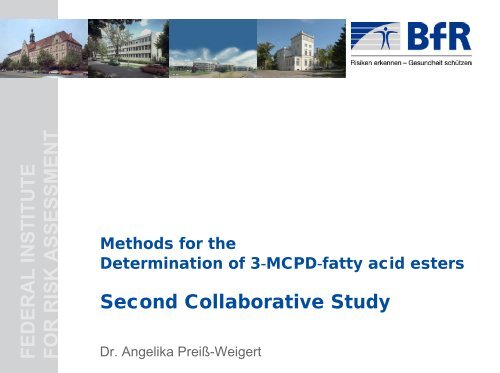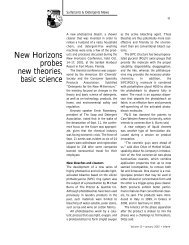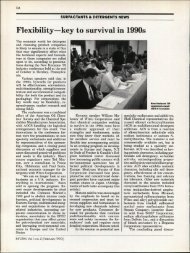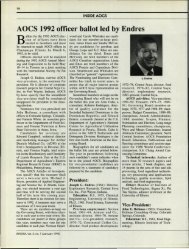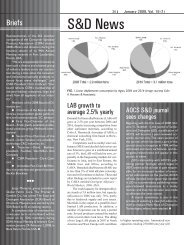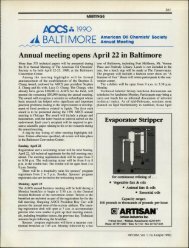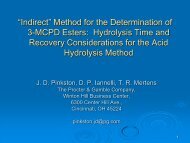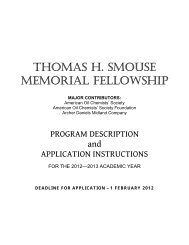Methods for the determination of 3-MCPD-fatty acid esters
Methods for the determination of 3-MCPD-fatty acid esters
Methods for the determination of 3-MCPD-fatty acid esters
Create successful ePaper yourself
Turn your PDF publications into a flip-book with our unique Google optimized e-Paper software.
FEDERAL INSTITUTE<br />
FOR RISK ASSESSMENT<br />
<strong>Methods</strong> <strong>for</strong> <strong>the</strong><br />
Determination <strong>of</strong> 3-<strong>MCPD</strong>-<strong>fatty</strong> <strong>acid</strong> <strong>esters</strong><br />
Second Collaborative Study<br />
Dr. Angelika Preiß-Weigert
December 2007 Federal Ministry <strong>of</strong> Food, Agriculture<br />
and Consumer Protection<br />
established two Working Groups on<br />
3-<strong>MCPD</strong>-Fatty Acid Esters in Refined Oils<br />
1 „Working Group on Research and Measures“<br />
2 „Working Group <strong>for</strong> Analytical Aspects“<br />
to be chaired by <strong>the</strong> BfR (Federal Institute <strong>for</strong> Risk<br />
Assessment)<br />
Mandate<br />
to test <strong>the</strong> analytical method developed in<br />
CVUA Stuttgart in a collaborative study<br />
Weißhaar et al, EJLST, 2008, 110, 183-186<br />
Angelika Preiß-Weigert 18 May 2010 3rd Meeting AOCS Expert Panel on Process Contaminants page 2
First BfR Collaborative Study (2008)<br />
Results <strong>of</strong> Method Validation Study and Pr<strong>of</strong>iciency-Test<br />
Gehalt 3-<strong>MCPD</strong> (mg/kg)<br />
[mg/kg]<br />
12<br />
10<br />
8<br />
6<br />
4<br />
2<br />
0<br />
Rape Seed Oil Oilve Oil Safflower Oil Grape Seed Oil Soild Fat<br />
Rapsöl Olivenöl Distelöl Traubenkernöl Fett<br />
Variante A (20) Variante A*/B (10) Variante C (4)<br />
Original methodR<br />
ih 1 Modified methodsOli<br />
In-house methods Oli<br />
CVUA Stuttgart (20) (6+4)<br />
(4)<br />
Angelika Preiß-Weigert 18 May 2010 3rd Meeting AOCS Expert Panel on Process Contaminants page 3
First Collaborative Study (2008)<br />
Conclusions<br />
Working Group <strong>for</strong> Analytical Aspects<br />
<strong>Methods</strong> providing chloride ions lead to excessive 3-<strong>MCPD</strong> <strong>fatty</strong><br />
<strong>acid</strong> values.<br />
It was concluded that chloride ions in combination with an<br />
unknown substance x can react to 3-<strong>MCPD</strong> during <strong>the</strong> analysis.<br />
• this substance x could be esterified glycidyl.<br />
MRI and DGF (March 2009, DGF C-III 18 (09))<br />
published this method <strong>for</strong> <strong>the</strong> <strong>determination</strong> <strong>of</strong><br />
3-<strong>MCPD</strong> <strong>MCPD</strong> FA Esters and <strong>MCPD</strong> <strong>for</strong>ming substances…<br />
substances<br />
BfR position<br />
Due to <strong>the</strong> different toxicological effects <strong>of</strong> 3-<strong>MCPD</strong> and glycidol<br />
<strong>the</strong> tested method is not an appropriate tool <strong>for</strong> risk assessment<br />
purposes.<br />
Angelika Preiß-Weigert 18 May 2010 3rd Meeting AOCS Expert Panel on Process Contaminants page 4
Strategy <strong>for</strong> <strong>the</strong> Development <strong>of</strong> BfR methods<br />
General Objectives<br />
to determine exclusively 3-<strong>MCPD</strong> FAE<br />
to <strong>of</strong>fer a sufficient robustness <strong>for</strong> adoption in routine labs<br />
Direct Method versus Indirect Method? Method<br />
Direct methods like LC-MS/MS <strong>of</strong> <strong>the</strong> <strong>esters</strong><br />
- guarant high specificity<br />
- require <strong>the</strong> availability <strong>of</strong> <strong>the</strong> complete „set <strong>of</strong> standard materials“<br />
- require very low LOD/LOQ <strong>for</strong> each single 3-<strong>MCPD</strong> FAE<br />
- <strong>of</strong>fer a limited robustness<br />
Indirect methods like GC-MS <strong>of</strong> <strong>the</strong> free 3-<strong>MCPD</strong><br />
- <strong>of</strong>fer an increased robustness<br />
- involve hydrolysis and derivatization<br />
- might induce chemical modifications <strong>of</strong> <strong>the</strong> analyte<br />
Final Decision <strong>for</strong> <strong>the</strong> development <strong>of</strong> indirect methods<br />
However, with <strong>the</strong> additional obligation that several methods should be<br />
tested applying different types <strong>of</strong> hydrolysis.<br />
hydrolysis<br />
Angelika Preiß-Weigert 18 May 2010 3rd Meeting AOCS Expert Panel on Process Contaminants page 5
Requirements fulfilled by <strong>the</strong> BfR methods<br />
1. Without addition <strong>of</strong> sodium chloride<br />
2. Hydrolysis <strong>of</strong> <strong>the</strong> (di)<strong>esters</strong><br />
• alkaline<br />
• <strong>acid</strong>ic<br />
3. Derivatisation <strong>of</strong> 3-<strong>MCPD</strong> with<br />
• Phenylboronic <strong>acid</strong><br />
• Heptafluorbutyric Anhydride<br />
4. Increase in robustness<br />
• additional cleanup / change <strong>of</strong> solvent<br />
5. Increase in practicability<br />
• reduction <strong>of</strong> volumes<br />
Angelika Preiß-Weigert 18 May 2010 3rd Meeting AOCS Expert Panel on Process Contaminants page 6
Characteristics <strong>of</strong> <strong>the</strong> methods<br />
Hydrolysis<br />
reagent<br />
Stop<br />
reagent<br />
Derivatisation<br />
reagent<br />
BfR Method 8<br />
H 2 SO 4<br />
Fat/Oil sample (100-200 mg), Addition <strong>of</strong> d 5 -3-<strong>MCPD</strong><br />
2 h + 16 h<br />
NaHCO 3<br />
phenylboronic <strong>acid</strong><br />
BfR Method 9 BfR Method 10<br />
NaOCH 3<br />
9-10 min<br />
(NH4) 2SO4 / H2SO4<br />
phenylboronic <strong>acid</strong><br />
GC-MS<br />
NaOCH 3<br />
9-10 min<br />
(NH4) 2SO4 / H2SO4<br />
HFBA<br />
Angelika Preiß-Weigert 18 May 2010 3rd Meeting AOCS Expert Panel on Process Contaminants page 7
Participants <strong>of</strong> <strong>the</strong> Second Collaborative Study<br />
40 laboratories received samples<br />
36 laboratories reported results<br />
2 laboratories applied 4 different methods<br />
1 laboratory applied 3 different methods<br />
2 laboratories applied 2 different methods<br />
Germany 29 labs<br />
Switzerland 2 labs<br />
Austria 1 lab<br />
Italy 2 labs<br />
Belgium 1 lab<br />
The Ne<strong>the</strong>rlands 1 lab<br />
Official control laboratories<br />
13 labs (all from Germany)<br />
Free market labs and industrial:<br />
23 labs<br />
Angelika Preiß-Weigert 18 May 2010 3rd Meeting AOCS Expert Panel on Process Contaminants page 8
Sample materials Second Collaborative Study<br />
3-<strong>MCPD</strong>-Content<br />
Quality control sample 3.0 ± 0.5 mg/kg<br />
(solid fat (first coll.study))<br />
Vegetable oil ~ 0.2 mg/kg<br />
Vegetable fat (hydrogenated) ~ 1.0 mg/kg<br />
Frying oil (non-hydrogenated) ~ 1.6 mg/kg<br />
Vegetable fat (hydrogenated) ~ 3.2 mg/kg<br />
Grape seed oil ~ 3.9 mg/kg<br />
Angelika Preiß-Weigert 18 May 2010 3rd Meeting AOCS Expert Panel on Process Contaminants page 9
Evaluation data<br />
48 datasets<br />
- BfR-Method 8 6 Labs<br />
- BfR-Method 9 27 Labs<br />
- BfR-Method 10 6 Labs<br />
- in-house methods 9 Labs<br />
⇒ Validation <strong>of</strong> „BfR Method 9“ 27 Datasets<br />
Pr<strong>of</strong>iciency Test 48 Datasets<br />
Angelika Preiß-Weigert 18 May 2010 3rd Meeting AOCS Expert Panel on Process Contaminants page 10
3-<strong>MCPD</strong>-<strong>fatty</strong> <strong>acid</strong> <strong>esters</strong> [mg/kg] in a solid fat sample<br />
3-<strong>MCPD</strong> (mg/kg)<br />
13,00<br />
12,00<br />
11,00<br />
10,00<br />
9,00<br />
8,00<br />
7,00<br />
6,00<br />
5,00<br />
4,00<br />
3,00<br />
2,00<br />
1,00<br />
0,00<br />
First Collaborative<br />
study<br />
BfR-<strong>Methods</strong> inhouse validation<br />
original method CVUA Stuttgart<br />
In-house methods<br />
Nummer Serie modified method CVUA Stuttgart<br />
BfR-Method 10<br />
BfR-Method 9 BfR-Method 8<br />
respecive mean values 2.Collaborative Study - Part I, all methods<br />
Angelika Preiß-Weigert 18 May 2010 3rd Meeting AOCS Expert Panel on Process Contaminants page 11<br />
Second Collaborative<br />
study
Results Second Collaborative Study - method validation -<br />
“BfR-Method 9” Statistical data <strong>for</strong> all sample materials (ISO 5725-2 / -3)<br />
L_Oel B_Fett F_Oel P_Fett T_Oel Cont<br />
Mean value <strong>of</strong> 3-<strong>MCPD</strong> [mg/kg] 0.30 0.91 1.72 3.46 4.04 2.96*)<br />
Rel. SD according to Horwitz [%] 19.17 16.23 14.74 13.27 12.96 13.59<br />
Rel. reproducibility SDs R (rel.s R )[%] 55.22 22.87 16.38 15.77 15.26 12.82<br />
Number <strong>of</strong> datasets<br />
(after elimination <strong>of</strong> outliers)<br />
19 25 25 25 25 23<br />
Total <strong>of</strong> datasets 27 **) 27 27 27 27 27<br />
Number <strong>of</strong> outliers ***) 2 1 1 1 1 3<br />
Ratio sr/sR 0.29 0.50 0.49 0.47 0.45 0.48<br />
HorRat 2.9 1.4 1.1 1.2 1.2 0.9<br />
*) <strong>the</strong> concentration <strong>of</strong> <strong>the</strong> control sample was previously specified to be 3.0 ± 0.5 mg/kg<br />
**) five laboratories stated values as
Second Collaborative Study (2009)<br />
Method Validation Study and Pr<strong>of</strong>iciency-Test<br />
all methods 48 datasets<br />
BfR Method 9 27 datasets<br />
BfR Method 8 6 datasets<br />
3-<strong>MCPD</strong> (mg/kg)<br />
5,00<br />
4,50<br />
4,00<br />
3,50<br />
3,00<br />
2,50<br />
2,00<br />
1,50<br />
1,00<br />
0,50<br />
0,00<br />
mean values and reproducability standard deviations <strong>of</strong> <strong>the</strong> different sampel<br />
materials obtained <strong>for</strong> "BfR Method 8", "BfR Method 9"<br />
and <strong>the</strong> pr<strong>of</strong>iciency test (all methods)<br />
Plant Oil Vegetable Fat Frying Oil Solid plant fat Grape seed oil Control sample<br />
sample materials<br />
all methods (n=47) BfR-Method 9 (n=26) BfR-Methode 8 (n=6)<br />
Rih4 Rih5 Rih6<br />
Angelika Preiß-Weigert 18 May 2010 3rd Meeting AOCS Expert Panel on Process Contaminants page 13
z-Score<br />
Results Second Collaborative Study<br />
Pr<strong>of</strong>iciency Test: Participant‘s z-Scores <strong>for</strong> <strong>the</strong> Frying Oil sample<br />
3,50<br />
3,00<br />
2,50<br />
2,00<br />
1,50<br />
1,00<br />
0,50<br />
0,00<br />
-0,50<br />
-1,00<br />
-1,50<br />
-2,00<br />
-2,50<br />
-3,00<br />
-3,50<br />
LC0032<br />
LC0018<br />
LC0029<br />
LC0001<br />
LC0021<br />
LC0008<br />
LC0004<br />
LC0111<br />
LC0225<br />
LC0013<br />
LC0311<br />
LC0030<br />
LC0011<br />
LC0039<br />
LC0211<br />
LC0213<br />
LC0325<br />
LC0302<br />
mean value 1,69 mg/kg<br />
LC0016<br />
LC0102<br />
LC0031<br />
Angelika Preiß-Weigert 18 May 2010 3rd Meeting AOCS Expert Panel on Process Contaminants page 14<br />
LC0203<br />
LC0003<br />
LC0028<br />
LC0202<br />
LC0012<br />
Labcode<br />
BfR Method 8 BfR Method 9 BfR Method 10 In-house methods<br />
LC0101<br />
LC0009<br />
LC0019<br />
LC0027<br />
LC0022<br />
LC0024<br />
LC0002<br />
LC0040<br />
LC0025<br />
LC0038<br />
LC0035<br />
LC0017<br />
LC0006<br />
LC0005<br />
LC0020<br />
LC0034<br />
LC0007<br />
LC0033<br />
LC0432<br />
LC0010<br />
LC0015<br />
LC0026
z-Score<br />
Results Second Collaborative Study<br />
Pr<strong>of</strong>iciency Test: Participant‘s z-Scores <strong>for</strong> <strong>the</strong> Grape Seed Oil sample<br />
3,50<br />
3,00<br />
2,50<br />
2,00<br />
1,50<br />
1,00<br />
0,50<br />
0,00<br />
-0,50<br />
-1,00<br />
-1,50<br />
-2,00<br />
-2,50<br />
-3,00<br />
-3,50<br />
LC0032<br />
LC0018<br />
LC0008<br />
LC0021<br />
LC0024<br />
LC0004<br />
LC0011<br />
LC0311<br />
LC0111<br />
LC0029<br />
LC0028<br />
LC0302<br />
LC0019<br />
LC0213<br />
LC0001<br />
LC0020<br />
mean value 3,39 mg/kg<br />
BfR Method 8 BfR Method 9 BfR Method 10 In-house methods<br />
LC0013<br />
LC0225<br />
LC0017<br />
LC0211<br />
LC0016<br />
LC0102<br />
Angelika Preiß-Weigert 18 May 2010 3rd Meeting AOCS Expert Panel on Process Contaminants page 15<br />
LC0039<br />
LC0027<br />
LC0005<br />
LC0009<br />
Labcode<br />
LC0002<br />
LC0012<br />
LC0022<br />
LC0035<br />
LC0202<br />
LC0040<br />
LC0203<br />
LC0432<br />
LC0325<br />
LC0025<br />
LC0031<br />
LC0003<br />
LC0030<br />
LC0033<br />
LC0007<br />
LC0006<br />
LC0034<br />
LC0010<br />
LC0101<br />
LC0038<br />
LC0015<br />
LC0026
Conclusions <strong>of</strong> Second Collaborative Study<br />
Results <strong>of</strong> <strong>the</strong> Method Validation and <strong>the</strong> Pr<strong>of</strong>iciency Test<br />
1. „BfR Method 9“ delivered reproducible results, which are<br />
comparable with <strong>the</strong> results <strong>of</strong><br />
all applied „in-house“ methods<br />
<strong>acid</strong>ic hydrolysis „BfR Method 8“<br />
HFBA derivatization „BfR Method 10“<br />
2. more than 90% <strong>of</strong> <strong>the</strong> laboratories reached a z-score < |2| <strong>for</strong> all<br />
five samples<br />
Angelika Preiß-Weigert 18 May 2010 3rd Meeting AOCS Expert Panel on Process Contaminants page 16
Third Collaborative Study in fat containing foods<br />
Schedule<br />
Types <strong>of</strong> Food Infant <strong>for</strong>mula<br />
Margarine<br />
Hazelnut or Chocolate Spread<br />
The work <strong>for</strong> preparing <strong>the</strong> study - like method development and<br />
homogeneity studies - is still ongoing<br />
Shipment <strong>of</strong> samples October 2010<br />
Report <strong>of</strong> results December 2010<br />
Finalization <strong>of</strong> evaluation March 2011<br />
You are kindly invited to participate in this study.<br />
Angelika Preiß-Weigert 18 May 2010 3rd Meeting AOCS Expert Panel on Process Contaminants page 17
FEDERAL INSTITUTE<br />
FOR RISK ASSESSMENT<br />
Thank you <strong>for</strong> your attention<br />
Angelika Preiß-Weigert<br />
Federal Institut <strong>for</strong> Risk Assessment<br />
Thielallee 88-92 D-14195 Berlin<br />
Tel. 0 30 - 8412 - 0 Fax 0 30 - 8412 4741<br />
bfr@bfr.bund.de www.bfr.bund.de<br />
Angelika.Preiss-Weigert@bfr.bund.de
Second Collaborative Study - Pr<strong>of</strong>iciency Test -<br />
Overview <strong>of</strong> z-Scores <strong>for</strong> all samples and <strong>for</strong> each laboratory<br />
z-Score<br />
5<br />
4<br />
3<br />
2<br />
1<br />
0<br />
-1<br />
-2<br />
-3<br />
-4<br />
-5<br />
LC0002<br />
LC0003<br />
LC0011<br />
LC0013<br />
LC0024<br />
LC0025<br />
LC0033<br />
LC0203<br />
In-house methods<br />
LC0432<br />
LC0001<br />
LC0019<br />
LC0028<br />
LC0029<br />
LC0102<br />
LC0111<br />
LC0004<br />
LC0005<br />
LC0006<br />
z-Scores <strong>of</strong> all sample materials<br />
LC0007<br />
LC0009<br />
BfR Method 8 BfR Method 9<br />
BfR Method 10<br />
Angelika Preiß-Weigert 18 May 2010 3rd Meeting AOCS Expert Panel on Process Contaminants page 19<br />
LC0010<br />
LC0012<br />
LC0016<br />
LC0017<br />
Labcode<br />
LC0018<br />
LC0020<br />
LC0021<br />
LC0022<br />
LC0026<br />
LC0027<br />
LC0030<br />
LC0032<br />
LC0034<br />
LC0035<br />
LC0038<br />
LC0039<br />
LC0040<br />
LC0101<br />
B_Fett L_Oel F_Oel P_Fett T_Oel<br />
LC0202<br />
LC0211<br />
LC0213<br />
LC0225<br />
LC0008<br />
LC0015<br />
LC0031<br />
LC0302<br />
LC0311<br />
LC0325
Methode „BfR 8“<br />
saure Hydrolyse. Phenylboronsäure-Derivatisierung<br />
100 mg Probe in 0.5 ml tert. Butylmethyle<strong>the</strong>r<br />
20 µl d 5 <strong>MCPD</strong><br />
2 x 1 ml Hexan<br />
1.8 ml H 2 SO 4<br />
2 h + 16 h<br />
PBA Derivatisierung in Aceton<br />
3 x 1 ml Cyclohexan<br />
0.5 ml NaHCO 3<br />
N 2.<br />
Lösen in i-Oktan<br />
2 – 3 min<br />
GC-MS<br />
Angelika Preiß-Weigert 18 May 2010 3rd Meeting AOCS Expert Panel on Process Contaminants page 20
Methode „BfR 9“<br />
Umesterung im Alkalischen. Phenylboronsäure-Derivatisierung<br />
2 – 3 min<br />
100 mg Probe in 0.5 ml tert. Butylmethyle<strong>the</strong>r<br />
20 µl d 5 <strong>MCPD</strong><br />
2 x 1 ml Hexan<br />
0.2 ml NaOCH 3 - Lösung<br />
PBA – Derivatisierung<br />
in Diethyle<strong>the</strong>r<br />
9 – 10 min<br />
0.5 ml (NH 4 ) 2 SO 4 / H 2 SO 4<br />
2 x 0.6 ml EtOAc<br />
N 2 . 40 C<br />
Lösen in Aceton<br />
GC-MS<br />
Angelika Preiß-Weigert 18 May 2010 3rd Meeting AOCS Expert Panel on Process Contaminants page 21
Methode „BfR 10“<br />
Umesterung im Alkalischen. Heptafluorbuttersäure-Derivatisierung<br />
20 min<br />
100 mg Probe in 0.5 ml tert. Butylmethyle<strong>the</strong>r<br />
20 µl d 5 <strong>MCPD</strong><br />
2 x 1 ml Hexan<br />
0.2 ml NaOCH 3 - Lösung<br />
HFBA – Derivatisierung<br />
in i-Oktan<br />
10 min<br />
0.5 ml (NH 4 ) 2 SO 4 / H 2 SO 4<br />
2 x 0.6 ml EtOAc<br />
250 µl H 2 O<br />
GC-MS<br />
Angelika Preiß-Weigert 18 May 2010 3rd Meeting AOCS Expert Panel on Process Contaminants page 22


